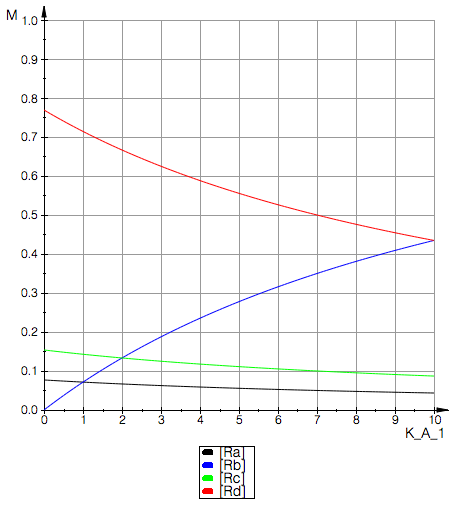
Analysis of I_abcd model
Intramolecular isomerization between four forms

4. Summary of some graphical results
6. Reproduce a graph for equilibrium concentrations using a numeric solution
7. Save results on disk for future use
In this notebook I will analyze and test the I_abcd model.
clean up workspace
reset()
Set path to save results into:
ProjectName:="I_abcd";
CurrentPath:="/Users/kovrigin/Documents/Workspace/Global Analysis/IDAP/Mathematical_models/Equilibrium_thermodynamic_models/I_abcd/";
![]()

Read results of derivations
filename:=CurrentPath.ProjectName.".mb";
fread(filename,Quiet):

Display equations (change : for ; to see the equation. Makes Mupad slow if all shown)
Eq_Raeq_I_abcd;
Eq_Rbeq_I_abcd;
Eq_Rceq_I_abcd;
Eq_Rdeq_I_abcd;
Eq_KB2_I_abcd;





Display functions
fRaeq_I_abcd;
fRbeq_I_abcd;
fRceq_I_abcd;
fRdeq_I_abcd




Set some realistic values for constants:
Total_R:=1;
Ka1:=5;
Ka2:=5;
Kb1:=2;
K_max:=10;
![]()
![]()
![]()
![]()
![]()
pRaeq:= plot::Function2d(
Function=(fRaeq_I_abcd(Total_R, K_A_1, Ka2, Kb1)),
LegendText="[Ra]",
Color = RGB::Black,
XMin=(0),
XMax=(K_max),
XName=(K_A_1),
TitlePositionX=(0)):
pRbeq:= plot::Function2d(
Function=(fRbeq_I_abcd(Total_R, K_A_1, Ka2, Kb1)),
LegendText="[Rb]",
Color = RGB::Blue,
XMin=(0),
XMax=(K_max),
XName=(K_A_1),
TitlePositionX=(0)):
pRceq:= plot::Function2d(
Function=(fRceq_I_abcd(Total_R, K_A_1, Ka2, Kb1)),
LegendText="[Rc]",
Color = RGB::Green,
XMin=(0),
XMax=(K_max),
XName=(K_A_1),
TitlePositionX=(0)):
pRdeq:= plot::Function2d(
Function=(fRdeq_I_abcd(Total_R, K_A_1, Ka2, Kb1)),
LegendText="[Rd]",
Color = RGB::Red,
XMin=(0),
XMax=(K_max),
XName=(K_A_1),
TitlePositionX=(0)):
plot(pRaeq,pRbeq,pRceq,pRdeq, YAxisTitle="M",
Height=180, Width=160,TicksLabelFont=["Helvetica",12,[0,0,0],Left],
AxesTitleFont=["Helvetica",14,[0,0,0],Left],
XGridVisible=TRUE, YGridVisible=TRUE,
LegendVisible=TRUE, LegendFont=["Helvetica",14,[0,0,0],Left],
ViewingBoxYMin=0, ViewingBoxYMax=1);

Simple test results
|
Total_R:=1;
Here the C and D species do not form. As KA1 rises we populate B. |
|
|
Total_R:=1;
Here, B is not formed in the beginning, C is 2xA and D is 5xC or 10xA.
As KA1 rises we create more B and reduce D. When KA1=10 we see the same amount of B and D so KB2=1
We derived:
so 5*2/10=1 !!! Yes, the derivation of the model is correct.
|
|
|
|
|
|
|
|
|
|
|
|
|
|
|
|
|
|
|
|
|
|
|
|
|
|
Conclusions
1. I analyzed analytical solutions for the U_R_RL system. They analytical solutions seem to work correctly.